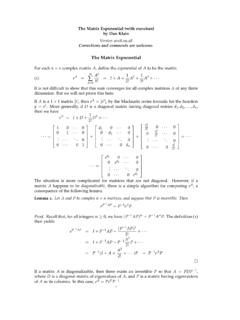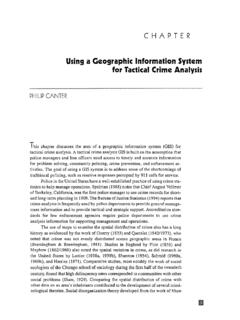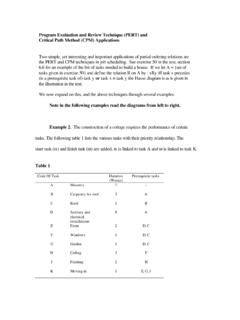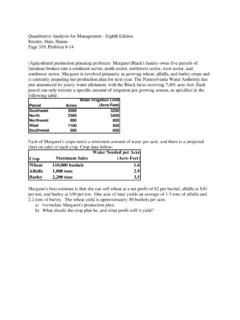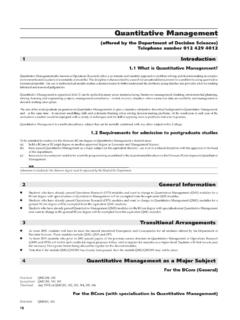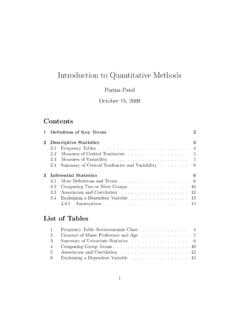Transcription of Introduction toIntroduction to QuaQua t tat e a ys ...
1 Chapter 1 Chapter 1 Introduction toIntroduction to quantitative AnalysisQua t tat ea ys s 2008 Prentice-Hall, analysis for Management, Tenth Edition,by Render, Stair, and HannaLearning ObjectivesLearning ObjectivesAfter completing this chapter, students will be able to:After completing this chapter, students will be able the quantitative analysis approach2 Understand the application of quantitativeAfter completing this chapter, students will be able to:After completing this chapter, students will be able the application of quantitative analysis in a real the use of modeling in quantitative computers and spreadsheet models to perform quantitative possible problems in using quantitative analysis6 Perform a breakeven analysis 2009 Prentice-Hall, Inc. 1 a break-even analysisChapter OutlineChapter Is quantitative analysis ? quantitative analysis to Develop a quantitative analysis Role of Computers and Role of Computers and Spreadsheet Models in the quantitative analysis Approach16 Possible Problems in the Problems in the quantitative analysis Not Just the Final Step 2009 Prentice-Hall, Inc.
2 1 3 IntroductionIntroduction Mathematical tools have been used for thousands of yearsQii li b lid quantitative analysis can be applied to a wide variety of problems It s not enough to just know the It s not enough to just know the mathematics of a technique One must understand the specificOne must understand the specific applicability of the technique, its limitations, and its assumptions 2009 Prentice-Hall, Inc. 1 4 Examples of quantitative AnalysesExamples of quantitative Analyses Taco Bell saved over $150 million using forecasting and scheduling quantitative analysis modelsanalysis models NBC television increased revenues by over $200 million by using quantitative ygqanalysis to develop better sales plans Continental Airlines saved over $40 illiitit tilimillion using quantitative analysis models to quickly recover from weather delays and other disruptions 2009 Prentice-Hall, Inc.
3 1 5ypWhat is quantitative analysis ?QtittiliQtittiliiitifihWhat is quantitative analysis ? quantitative analysisQuantitative analysisis a scientific approach to managerial decision making whereby raw data are processed and manipulateddata are processed and manipulated resulting in meaningful informationMeaningfulInformationQuantita tiveAnalysisRaw DataInformationAnalysis 2009 Prentice-Hall, Inc. 1 6 What is quantitative analysis ?What is quantitative analysis ? quantitative factorsQuantitative factorsmight be different investment alternatives, interest rates, inventory levels demand or labor costinventory levels, demand, or labor costQualitative factorsQualitative factorssuch as the weather, state and federal legislation, and g,technology breakthroughs should also be considered Information ma be diffic lt to q antif b t Information may be difficult to quantify but can affect the decision-making process 2009 Prentice-Hall, Inc.
4 1 7 The quantitative analysis Approache Qua t tat ea ys s pp oacDefining the ProblemDeveloping a ModelDli SltiAcquiring Input DataTesting the SolutionDeveloping a SolutionAnalyzing the Resultsg 2009 Prentice-Hall, Inc. 1 8 Implementing the ResultsFigure the ProblemDefining the ProblemNeed to develop a clear and conciseNeed to develop a clear and concise statement that gives direction and meaning to the following steps This may be the most important and difficult step It is essential to go beyond symptoms and gy ypidentify true causes May be necessary to concentrate on only a few of the problems selecting the right problemsof the problems selecting the right problems is very important Specific and measurable objectives may have to be developed 2009 Prentice-Hall, Inc. 1 9to be developedDeveloping a ModelDeveloping a ModelQuantitative analysis models are realistic, ysolvable, and understandable mathematical representations of a situationSalesThere are different types of models$ Advertising$ There are different types of modelsSchematic Scale 2009 Prentice-Hall, Inc.
5 1 10modelsmodelsDeveloping a ModelDeveloping a Model Models generally contain variables (controllable and uncontrollable) and parametersparameters Controllable variables are generally the decision variables and are generallydecision variables and are generally unknown Parameters are known quantities that are a part of the problem 2009 Prentice-Hall, Inc. 1 11 Acquiring Input DataAcquiring Input DataInput data must be accurateGIGO ruleInput data must be accurate GIGO ruleGarbageGarbage InProcessGarbage OutData may come from a variety of sources such as company reports, company documents, interviews, 2009 Prentice-Hall, Inc. 1 12pyppyon-site direct measurement, or statistical samplingDeveloping a SolutionDeveloping a Solution The best (optimal) solution to a problem The best (optimal) solution to a problem is found by manipulating the model variables until a solution is found that is practical and can be implementedpractical and can be implemented Common techniques are SolvingSolvingequationsggq Trial and errorTrial and error trying various approaches and picking the best result Complete enumerationComplete enumeration trying all possibleComplete enumerationComplete enumerationtrying all possible values Using an algorithmalgorithm a series of repeating steps to reach a solution 2009 Prentice-Hall, Inc.
6 1 13pTesting the SolutionTesting the SolutionBoth input data and the model should beBoth input data and the model should be tested for accuracy before analysis and implementationp New data can be collected to test the model Results should be logical, consistent, and represent the real situationrepresent the real situation 2009 Prentice-Hall, Inc. 1 14 Analyzing the ResultsAnalyzing the ResultsDetermine the implications of the solutionDetermine the implications of the solution Implementing results often requires change in an organizationTh it ftihd t The impact of actions or changes needs to be studied and understood before implementationSensitivity analysisSensitivity analysisdetermines how much the results of the analysis will change ifthe results of the analysis will change if the model or input data changes Sensitive models should be very thoroughly ttd 2009 Prentice-Hall, Inc.
7 1 15testedImplementing the ResultsImplementing the ResultsImplementation incorporates the solutionImplementation incorporates the solution into the company Implementation can be very difficult People can resist changes Many quantitative analysis efforts have failed because a good, workable solution was notbecause a good, workable solution was not properly implementedChanges occur over time, so even fli lttitbsuccessful implementations must be monitored to determine if modifications are necessary 2009 Prentice-Hall, Inc. 1 16necessaryModeling in the Real WorldModeling in the Real WorldQuantitative analysis models are usedQuantitative analysis models are used extensively by real organizations to solve real problemsp In the real world, quantitative analysis models can be complex, expensive, and difficult to selldifficult to sell Following the steps in the process is an important component of success 2009 Prentice-Hall, Inc.
8 1 17 How To Develop a quantitative AliMdlAnalysis Model An important part of the quantitative analysis approach Let s look at a simple mathematical Let s look at a simple mathematical model of profitProfit = Revenue Expenses 2009 Prentice-Hall, Inc. 1 18 How To Develop a quantitative AliMdlAnalysis ModelExpenses can be represented as the sum of fixed and ibltdibltthd t fvariable costs and variable costs are the product of unit costs times the number of unitsProfit =Revenue(Fixed cost + Variable cost)Profit =Revenue (Fixed cost + Variable cost)Profit = (Selling price per unit)(number of units sold) [Fixed cost + (Variable costs per i )(Nbfild)]unit)(Number of units sold)]Profit =sX [f+vX]Profit =sXfvXProfit =sX f vXwheres=selling price per unitv=variable cost per unit 2009 Prentice-Hall, Inc. 1 19s selling price per unitv variable cost per unitf= fixed costX= number of units soldHow To Develop a quantitative AliMdlAnalysis ModelExpenses can be represented as the sum of fixed and ibltdibltthd t fvariable costs and variable costs are the product of unit costs times the number of unitsProfit =Revenue(Fixed cost + Variable cost)The parametersof this model are f, v, and sas these are the inputs inherent in the modelProfit =Revenue (Fixed cost + Variable cost)Profit = (Selling price per unit)(number of units sold) [Fixed cost + (Variable costs per i )(Nbfild)]pThe decision variableof interest is Xunit)(Number of units sold)]Profit =sX [f+vX]Profit =sXfvXProfit =sX f vXwheres=selling price per unitv=variable cost per unit 2009 Prentice-Hall, Inc.
9 1 20s selling price per unitv variable cost per unitf= fixed costX= number of units soldPritchett s Precious Time PiecesPritchett s Precious Time PiecesThe company buys, sells, and repairs old clocks. R b iltill f$10it Fi dt fRebuilt springs sell for $10 per unit. Fixed cost of equipment to build springs is $1,000. Variable cost for spring material is $5 per 10f= 1,000v= 5 Number of spring sets sold = XProfits = sX f vXIfl0fit$1 000$1 000If sales = 0, profits = $1,000$1,000If sales = 1,000, profits = [(10)(1,000) 1,000 (5)(1,000)]$4 000 2009 Prentice-Hall, Inc. 1 21= $4,000 Pritchett s Precious Time PiecesPritchett s Precious Time PiecesCompanies are often interested in their breakbreak--even even itit(BEP) Th BEP i thbfitld00()pointpoint(BEP). The BEP is the number of units sold that will result in $0 = sX f vX, or 0 = (s v)X fSolving for X, we have()f = (s v)XX=fX s vBEP =Fixed cost 2009 Prentice-Hall, Inc.
10 1 22 BEP = (Selling price per unit) (Variable cost per unit)Pritchett s Precious Time PiecesPritchett s Precious Time PiecesCompanies are often interested in their breakbreak--even even itit(BEP) Th BEP i thbfitld00()pointpoint(BEP). The BEP is the number of units sold that will result in $0 for Pritchett s Precious Time PiecesBEP = $1 000/($10 $5) = 200 units0 = sX f vX, or 0 = (s v)X fSolving for X, we have()BEP = $1,000/($10 $5) = 200 unitsSales of less than 200 units of rebuilt springs will result in a lossf = (s v)XX=fwill result in a lossSales of over 200 units of rebuilt springs will result in a profitX s vBEP =Fixed cost 2009 Prentice-Hall, Inc. 1 23 BEP = (Selling price per unit) (Variable cost per unit)Advantages of Mathematical Modelinggg1 Models can accurately represent can accurately represent can help a decision maker formulate problemsformulate can give us insight and can save time and money in ydecision making and problem model may be the only way to solve large lblitilfhior complex problems in a timely model can be used to communicate problems and solutions to others 2009 Prentice-Hall, Inc.


